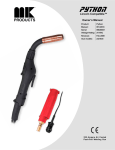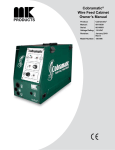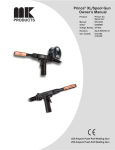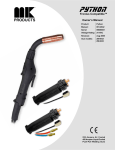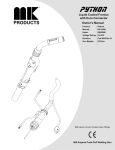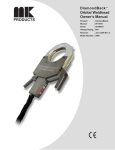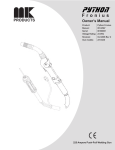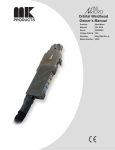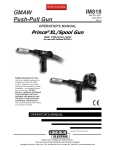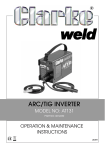Download Miller Electric MT-18V-25 Owner`s manual
Transcript
Sidewinder ® MiniSpool™ Gun Owner’s Manual Product: Sidewinder Manual: 091-0551 Serial: 09020001 Voltage Rating: 24/42/115 VDC Revision: Feb 2009 Rev D Gun models: 321-XXX 322-XXX 135 Ampere Push-Pull Welding Gun Table of Contents Safety Considerations............................................................................i-iv Installation................................................................................... Section A Technical Specifications...........................................................................................1 Support Equipment Required...................................................................................1 Operation....................................................................................Section B General.....................................................................................................................2 Barrels......................................................................................................................2 Controls and Settings ............................................................................................. 2. Drive Roll and Idler Rolls......................................................................................... 2 Accessories.................................................................................Section C Contact Tips ............................................................................................................3 Gas Cups ................................................................................................................3 Welding Wire............................................................................................................3 Optional Barrel Assemblies......................................................................................4 Optional Kits.............................................................................................................4 Maintenance................................................................................Section D Periodic Maintenance...............................................................................................4 Recommended Spare Parts List...............................................................................4 Troubleshooting...........................................................................Section E Troubleshooting Guide.............................................................................................5 Testing the Gun........................................................................................................6 Appendices................................................................................. Section F Diagrams/Parts List..................................................................................................7 SP-1 Configurations...............................................................................................14 Safety Warnings Warranty Declaration of Conformity for European Community (CE) Products Note This information is provided for units with CE certification (see rating label on unit). Manufacturer’s Name: MK Products, Inc. 16882 Armstrong Ave. Irvine, CA 92606 Declares that the product: Sidewinder® conforms to the following Directives and Standards: Directives Low Voltage Directive: 73/23/EEC Electromagnetic Compatibility (EMC) Directive: 89/336/EEC Standards Arc Welding Equipment Part I: Welding Power Sources: IEC 60974-1 (September 1998 - Second Edition) Arc Welding Equipment: Wirefeed Systems: IEC 974-5 (September 1997 - Draft Revision) Degrees of Protection Provided by Enclosures (IP Code): IEC 529:1989 (November 1989 - First Edition) Insulation Coordination For Equipment With Low-Voltage Systems: Part I: Principles, Requirements and Tests: IEC 664-1: 1992 (October 1992 - First Edition) Electromagnetic Compatibility, (EMC): EN 50199 (August 1995) Torches And Guns For Arc Welding, EN 50078 SAFETY CONSIDERATIONS ELECTRIC ARC WELDING EQUIPMENT Saftey CAUTION : READ BEFORE ATTEMPTING INSTALLATION, OPERATION OR Guidelines MAINTENANCE OF THIS EQUIPMENT 1-1 INTRODUCTION This equipment is intended for ultimate application by commercial/industrial users and for operation by persons trained and experienced in the use and maintenance of welding equipment. Operation should not be undertaken without adequate training in the use of such equipment. Training is available from many public and private schools or similar facilities. Safe practices in the installation, operation and maintenance of this equipment requires proper training in the art, a careful study of the information provided with the equipment, and the use of common sense. Rules for safe use are generally provided by suppliers of welding power sources, compressed gas suppliers, and electrode suppliers. Careful compliance with these rules will promote safe use of this equipment. The following Safety Rules cover some of the more generally found situations. READ THEM CAREFULLY. In case of any doubt, obtain qualified help before proceeding. 1-2 GENERAL PRECAUTIONS A. Burn Prevention ELECTRIC ARC WELDING PRODUCES HIGH INTENSITY HEAT AND ULTRAVIOLET RADIANT ENERGY WHICH MAY CAUSE SERIOUS AND PERMANENT EYE DAMAGE AND WHICH MAY DAMAGE ANY EXPOSED SKIN AREAS. Wear helmet with safety goggles or glasses with side shields underneath, appropriate filter lenses or plates (protected by clear cover glass). This is a must for welding or cutting (and chipping) to protect the eyes from radiant energy and flying metal. Replace cover glass when broken, pitted, or spattered. Medical first aid and eye treatment. First aid facilities and a qualified first aid person should be available for each shift unless medical facilities are close by for immediate treatment of flash burns of the eyes and skin burns. Wear protective clothing - leather (or asbestos) gauntlet gloves, hat, and high safety-toe shoes. Button shirt collar and pocket flaps, and wear cuffless trousers to avoid entry of sparks and slag. Avoid oily or greasy clothing. A spark may ignite them. Flammable hair preparations should not be used by persons intending to weld or cut. Hot metal such as electrode stubs and work pieces should never be handled without gloves. Ear plugs should be worn when working on overhead or in a confined space. A hard hat should be worn when others work overhead. B. Toxic Fume Prevention WARNING: The use of this product may result in exposure to chemicals known to the State of California to cause cancer and birth defects or other reproductive harm. Adequate ventilation. Severe discomfort, illness or death can result from fumes, vapors, heat, or oxygen enrichment or depletion that welding (or cutting) may produce. Prevent them with adequate ventilation. NEVER ventilate with oxygen. Lead-, cadmium-, zinc-, mercury-, beryllium-bearing and similar materials, when welded or cut, may produce harmful concentrations of toxic fumes. Adequate local exhaust ventilation must be used, or each person in the area, as well as the operator, must wear an air-supplied respirator. For beryllium, both must be used. Metals coated with or containing materials that emit toxic fumes should not be heated unless coating is removed form the work surface, the area is well ventilated, or the operator wears an air-supplied respirator. Work in a confined space only while it is being ventilated and, if necessary, while wearing an airsupplied respirator. Gas leaks in a confined space should be avoided. Leaked gas in large quantities can change oxygen concentration dangerously. Do not bring gas cylinders into a confined space. Leaving confined space, shut OFF gas supply at source to prevent possible accumulation of gases in the space if downstream valves have been accidentally opened or left open. Check to be sure that the space is safe before reentering it. Vapors from chlorinated solvents can be decomposed by the heat of the arc (or flame) to form PHOSGENE, a highly toxic gas, and other lung and eye irritating products. The ultraviolet (radiant) energy of the arc can also decompose trichloroethylene and perchloroethylene vapors to form phosgene. DO NOT WELD or cut where solvent vapors can be drawn into the welding or cutting atmosphere or where the radiant energy can penetrate to atmospheres containing even minute amounts of trichloroethylene or perchloroethylene. C. Fire and Explosion Prevention Causes of fire and explosion are: combustibles reached by the arc, flame, flying sparks, hot slag, or heated material, misuse of compressed gases and cylinders, and short circuits. BE AWARE THAT flying sparks or falling slag can pass through cracks, along pipes, through windows or doors, and through wall or floor openings, out of sight of the goggled operator. Sparks can fly many feet. To prevent fires and explosion: Keep equipment clean and operable, free of oil, grease, and (in electrical parts) of metallic particles that can cause short circuits. If combustibles are in area, do NOT weld or cut. Move the work if practicable, to an area free of combustibles. Avoid paint spray rooms, dip tanks, storage areas, ventilators. If the work cannot be moved, move combustibles at least 35 feet away, out of reach of sparks and heat; or protect against ignition with suitable and snugfitting, fire-resistant covers or shields. Walls touching combustibles on opposite sides should not be welded on (or cut). Walls, ceilings, and floor near work should be protected by heatresistant covers or shields. Fire watcher must be standing by with suitable fire extinguishing equipment during and for some time after welding or cutting if: 1. Appreciable combustibles (including building construction) are within 35 feet. 2. Appreciable combustibles are further than 35 feet, but can be ignited by sparks. 3. Openings (concealed or visible) in floors or walls within 35 feet may expose combustibles to sparks. 4. Combustibles adjacent to walls, ceilings, roofs, or metal partitions can be ignited by radiant or conducted heat. Hot work permit should be obtained before operation to ensure supervisor’s approval that adequate precautions have been taken. After work is done, check that area is free of sparks, glowing embers, and flames. An empty container that held combustibles, or that can produce flammable or toxic vapors when heated, must never be welded on or cut, unless container has first been cleaned in accordance with industry standards. This includes: a thorough steam or caustic cleaning (or a solvent of water washing, depending on the combustible’s solubility), followed by purging and inerting with nitrogen or carbon dioxide, and using protective equipment. Water-filling just below working level may substitute for inerting. A container with unknown contents should be cleaned (see paragraph above). Do NOT depend on sense of smell or sight to determine if it is safe to weld or cut. Hollow castings or containers must be vented before welding or cutting. They can explode. Explosive atmospheres. NEVER weld or cut where the air may contain flammable dust, gas, or liquid vapors (such as gasoline). D. Compressed Gas Equipment The safe handling of compressed gas equipment is detailed in numerous industry publications. The following general rules cover many of the most common situations. 1. Pressure Regulators Regulator relief valve is designed to protect only Sidewinder® MiniSpool™ Gun Owner's Manual - Page i the regulator from overpressure; it is not intended to protect any downstream equipment. Provide such protection with one or more relief devices. Never connect a regulator to a cylinder containing gas other than that for which the regulator was designed. Remove faulty regulator from service immediately for repair (first close cylinder valve). The following symptoms indicate a faulty regulator: Leaks - if gas leaks externally. Excessive Creep - if delivery pressure continues to rise with downstream valve closed. Faulty Gauge - if gauge pointer does not move off stop pin when pressurized, nor returns to stop pin after pressure release. Repair. Do NOT attempt repair. Send faulty regulators for repair to manufacturer’s designated repair center, where special techniques and tools are used by trained personnel. 2. Cylinders Cylinders must be handled carefully to prevent leaks and damage to their walls, valves, or safety devices: Avoid electrical circuit contact with cylinders including third rails, electrical wires, or welding circuits. They can produced short circuit arcs that may lead to a serious accident. (See 1-3C) ICC or DOT marking must be on each cylinder. It is an assurance of safety when the cylinder is properly handled. Identifying gas content. Use only cylinders with name of gas marked on them; do not rely on color to identify gas content. Notify supplier if unmarked. NEVER DEFACE or alter name, number, or other markings on a cylinder. It is illegal and hazardous. Empties: Keep valves closed, replace caps securely; mark MT; keep them separate from FULLS, and return promptly. Prohibited use. Never use a cylinder or its contents for other than its intended use, NEVER as a support or roller. Locate or secure cylinders so they cannot be knocked over. Passageways and work areas. Keep cylinders clear of areas where they may be stuck. Transporting cylinders. With a crane, use a secure support such as a platform or cradle. Do NOT lift cylinders off the ground by their valves or caps, or by chains, slings, or magnets. Do NOT expose cylinders to excessive heat, sparks, slag, and flame, etc. that may cause rupture. Do not allow contents to exceed 55 degrees C (130 degrees F.) Cool with water spray where such exposure exists. Protect cylinders, particularly valves from bumps, falls, falling objects, and weather. Replace caps securely when moving cylinders. Stuck valve. Do NOT use a hammer or wrench to open a cylinder valve that cannot be opened by hand. Notify your supplier. Mixing gases. NEVER try to mix any gases in a cylinder. NEVER refill any cylinder. Cylinder fittings should never be modified or exchanged. 3. Hose Prohibited use. Never use hose other than that designed for the specified gas. A general hose identification rule is: red for fuel gas, green for oxygen, and black for inert gases. Use ferrules or clamps designed for the hose (not ordinary wire or other substitute) as a binding to connect hoses to fittings. No copper tubing splices. Use only standard brass fittings to splice hose. Avoid long runs to prevent kinks and abuse. Suspend hose off ground to keep it from being run over, stepped on, or otherwise damaged. Coil excess hose to prevent kinks and tangles. Protect hose from damage by sharp edges, and by sparks, slag, and open flame. Examine hose regularly for leaks, wear, and loose connections. Immerse pressured hose in water; bubbles indicate leaks Repair leaky or worn hose by cutting area out and splicing. Do NOT use tape. 4. Proper Connections Clean cylinder valve outlet of impurities that may clog orifices and damage seats before connecting regulator. Except for hydrogen, crack valve momentarily, pointing outlet away from people and sources of ignition. Wipe with a clean, lintless cloth. Match regulator to cylinder. Before connecting, check that the regulator label and cylinder marking agree, and that the regulator inlet and cylinder outlet match. NEVER Connect a regulator designed for a particular gas or gases to a cylinder containing any other gas. Tighten connections. When assembling threaded connections, clean and smooth seats where necessary. Tighten. If connection leaks, disassemble, clean, and retighten, using properly fitting wrench. Adapters. Use a CGA adapter (available from your supplier) between cylinder and regulator, if one is required. Use two wrenches to tighten adapter marked RIGHT and LEFT HAND threads. Regulator outlet (or hose) connections may be identified by right hand threads for oxygen and left hand threads (with grooved hex on nut or shank) for fuel gas. 5. Pressurizing Steps: Drain regulator of residual gas through suitable vent before opening cylinder (or manifold valve) by turning adjusting screw in (clockwise). Draining prevents excessive compression heat at high pressure seat by allowing seat to open on pressurization. Leave adjusting screw engaged slightly on single-stage regulators. Stand to side of regulator while opening cylinder valve. Open cylinder valve slowly so that regulator pressure increases slowly. When gauge is pressurized (gauge reaches regulator maximum) leave cylinder valve in following position: for oxygen and inert gases, open fully to seal stem against possible leak; for fuel gas, open to less than one turn to permit quick emergency shut-off. Use pressure charts (available from your supplier) for safe and efficient recommended pressure settings on regulators. Check for leaks on first pressurization and regularly thereafter. Brush with soap solution. Bubbles indicate leaks. Clean off soapy water after test; dried soap is combustible. E. User Responsibilities Follow all Safety Rules. Remove leaky or defective equipment from service immediately for repair. Read and follow user manual instructions. F. Leaving Equipment Unattended Close gas supply at source and drain gas. G. Rope Staging-Support Rope staging-support should not be used for welding or cutting operation; rope may burn. 1-3 ARC WELDING Comply with precautions in 1-1, 1-2, and this section. Arc Welding, properly done, is a safe process, but a careless operator invites trouble. The equipment carries high currents at significant voltages. The arc is very bright and hot. Sparks fly, fumes rise, ultraviolet and infrared energy radiates, weldments are hot, and compressed gases may be used. The wise operator avoids unnecessary risks and protects himself and others from accidents. A. Burn Protection Comply with precautions in 1-2. The welding arc is intense and visibly bright. Its radiation can damage eyes, penetrate lightweight clothing, reflect from light-colored surfaces, and burn the skin and eyes. Skin burns resemble acute sunburn; those from gas-shielded arcs are more severe and painful. DON’T GET BURNED; COMPLY WITH PRECAUTIONS. 1. Protective Clothing Wear long-sleeve clothing in addition to gloves, hat, and shoes. As necessary, use additional protective clothing such as leather jacket or sleeves, flameproof apron, and fire-resistant leggings. Avoid outer garments of untreated cotton. Bare skin protection. Wear dark, substantial clothing. Button collar to protect chest and neck, and button pockets to prevent entry of sparks. 2. Eye and Head Protection Protect eyes from exposure to arc. Eyes may be damaged by radiant energy when exposed to the electric arc, even when not looking in the direction of the arc. Never look at an electric arc without protection. Welding helmet or shield containing a filter plate shade no. 12 or denser must be used when welding. Place over face before striking arc. Protect filter plate with a clear cover plate. Cracked or broken helmet or shield should NOT be worn; radiation can be passed through to cause burns. Cracked, broken, or loose filter plates must be replaced IMMEDIATELY. Replace clear cover plate when broken, pitted, or spattered. Flash goggles with side shields MUST be worn under the helmet to give some protection to the eyes should the helmet not be lowered over the face before an arc is struck. Looking at an arc momentarily with unprotected eyes (particularly a high intensity gas-shielded arc) can cause a Sidewinder® MiniSpool™ Gun Owner's Manual - Page ii retinal burn that may leave a permanent dark area in the field of vision. or the equipment will become electrically HOT - a dangerous condition that can shock, possibly fatally. 3. Protection of Nearby Personnel Enclose the welding area. For production welding, a separate room or enclosed bay is best. In open areas, surround the operation with low-reflective, noncombustible screens or panels. Allow for free air circulation, particularly at floor level. Before welding, check ground for continuity. Be sure conductors are touching bare metal of equipment frames at connections. Viewing the weld. Provide face shields for all persons who will be looking directly at the weld. Others working in area. See that all persons are wearing flash goggles. Before starting to weld, make sure that screen flaps or bay doors are closed. B. Toxic Fume Prevention Comply with precautions in 1-2B. Generator engine exhaust must be vented to the outside air. Carbon monoxide can kill. C. Fire and Explosion Prevention Comply with precautions in 1-2C. Equipment’s rated capacity. Do not overload arc welding equipment. It may overheat cables and cause a fire. Loose cable connections may overheat or flash and cause afire. Never strike an arc on a cylinder or other pressure vessel. It creates a brittle area that can cause a violent rupture or lead to such a rupture later under rough handling. D. Compressed Gas Equipment Comply with precautions in 1-2D. E. Shock Prevention Exposed electrically hot conductors or other bare metal in the welding circuit, or in ungrounded, electrically-HOT equipment can fatally shock a person whose body becomes a conductor. DO NOT STAND, SIT, LIE, LEAN ON, OR TOUCH a wet surface when welding without suitable protection. To protect against shock: Keep body and clothing dry. Never work in damp area without adequate insulation against electrical shock. Stay on a dry duckboard, or rubber mat when dampness or sweat cannot be avoided. Sweat, sea water, or moisture between body and an electrically HOT part - or grounded metal - reduces the body surface electrical resistance, enabling dangerous and possibly lethal currents to flow through the body. 1. Grounding the Equipment When installing, connect the frames of each unit such as welding power source, control, work table, and water circulator to the building ground. Conductors must be adequate to carry ground currents safely. Equipment made electrically HOT by stray currents may shock, possibly fatally. Do NOT GROUND to electrical conduit, or to a pipe carrying ANY gas or a flammable liquid such as oil or fuel. If a line cord with a ground lead is provided with the equipment for connection to a switch box, connect the ground lead to the grounded switch box. If a three-prong plug is added for connection to a grounded mating receptacle, the ground lead must be connected to the ground prong only. If the line cord comes with a three-prong plug, connect to a grounded mating receptacle. Never remove the ground prong from a plug, or use a plug with a broken ground prong. 2. Connectors Fully insulated lock-type connectors should be used to join welding cable lengths. 3. Cables Frequently inspect cables for wear, cracks, and damage. IMMEDIATELY REPLACE those with excessively worn or damaged insulation to avoid possibly lethal shock from bared cable. Cables with damaged areas may be taped to give resistance equivalent to original cable. Keep cable dry, free of oil and grease, and protected from hot metal and sparks. 4. Terminals and Other Exposed Parts Terminals and other exposed parts of electrical units should have insulating covers secured before operation. 5. Electrode Wire Electrode wire becomes electrically HOT when the power switch of gas metal-arc welding equipment is ON and welding gun trigger is pressed. Keep hands and body clear of wire and other HOT parts. 6. Safety Devices Safety devices such as interlocks and circuit breakers should not be disconnected or shunted out. Before installation, inspection, or service of equipment, shut OFF all power, and remove line fuses (or lock or red-tag switches) to prevent accidental turning ON of power. Disconnect all cables from welding power source, and pull all 115 volts line-cord plugs. Do not open power circuit or change polarity while welding. If, in an emergency, it must be disconnected, guard against shock burns or flash from switch arcing. Leaving equipment unattended. Always shut OFF, and disconnect all power to equipment. Power disconnect switch must be available near the welding power source. Three-phase connection. Check phase requirement of equipment before installing. If only three-phase power is available, connect single-phase equipment to only two wires of the three-phase line. Do NOT connect the equipment ground lead to the third (live) wire, Sidewinder® MiniSpool™ Gun Owner's Manual - Page iii Section A Installation Technical Specifications Wire Capacity • .023”, .030” & .035” (0.6, 0.8 & 0.9 mm) Aluminum Wire only Wire Speed* • 600 ipm (15.2 mpm) at 12VDC Motor Input Voltage Spool Size • 2-1/2” inches (63.5mm) Duty Cycle - All ratings are at 18V using Argon Gas • 20% @ 200 Amps • 60% @ 135 Amps *Maximum IPM varies depending on input voltage, wire size and the control box used. Support Equipment Required • • • CV or CC power source of sufficient capacity for your needs. Regulated gas supply and hoses. Properly sized power leads from power source. Welding Gun Lead Connections Power Cable - Air Cooled A #6 AWG welding power cable (75A, 600V rating) is used on the Sidewinder®. The power cable comes standard with a ring lug connector. Gas Hose The end of the Sidewinder® gas hose uses a 5/8”-18 IAA RH, male gas fitting, standard. Electric Cable A four-conductor control cable is used on the Sidewinder®. As the electrical diagram shows, two wires are used for motor voltage and two wires are used for the micro switch from the trigger mechanism. The control end has a fourpin CPC (Circular Plastic Connector). Spool Gun Setup Loading Electrode Wire Raise the Wire Restrainer until it clicks into place in the spool housing. With the welding wire coming off the top of the MiniSpool™, straighten out the first 2” to 3” of wire and push it through the liner inlet. Jog the trigger until the wire is picked up by drive rolls and fed through the contact tip. Press the MiniSpool™ of wire on to the spindle until it clicks into place. Lower the Wire Restrainer onto the wire surface. NOTE: The Wire Restrainer is designed to automatically control spool drag and keep the wire from jumping off the spool, no adjustment required. Sidewinder® MiniSpool™ Gun Owner's Manual - Page 1 Section B Operation General Description The 12 VDC Sidewinder® motor is controlled by an external motor/wire speed controller. This can be an intergral circuit within a welding power supply or through an MK Control Module. The trigger is designed so when it is partially depressed, gas flow starts via the valve located in the gun body - prior to ignition of the arc. When the trigger is partially released after welding - just as the arc is extinguished, gas flow continues until the trigger is fully released. This is designed as built-in Pre and Post gas flow. The 1/4” Contact Tips and the standard knurled Drive Roll used on the Sidewinder® are the same as those used on the Cobra® Gold or classic Gooseneck. Whereas the Gas Cups and the Idler Roll are unique to this gun. Barrels Barrel Selection The Sidewinder® MiniSpool™ gun is available with a 4” or 7” Straight Air Cooled barrel. Barrel Removal and Installation To remove a barrel assembly, the handles must first be removed. There are four socket screws which hold the barrel onto the front of the body assembly. The barrel assembly has a gas passage bayonet, with two o-rings, inserted into the body. Once the screws are removed, simply pull to remove the barrel from the body. To replace a barrel assembly, take care not to damage the o-rings when inserting into the body. Apply a small amount of o-ring lube to the o-rings, insert bayonet into body and secure with screws and washers previously removed. Reassemble handles to the gun. Controls and Settings Speed Control The wire speed of the Sidewinder® is controlled by variable DC motor input voltage either from a welding power supply with Wire Speed/Amperage Control or from an MK Control Module. The MK Control Module is designed to connect between the Sidewinder® and both the welding power supply and the input power for the module. While converting its input power to controllable DC motor voltage for welding wire speed, the MK Control Module interfaces the Sidewinder® trigger microswitch to the welding power supply contact closure signal. Reference Section F for Module connection configuration. Drive and Idler Rolls The Sidewinder® gun comes standard with a knurled drive roll (universal to all aluminum alloys) and a grooved idler roll designed for wire diameters from .023” to .035”. Drive roll tension is accomplished by means of a spring loaded idler lever, applying a constant - non-operator adjustable - but controlled pressure on the welding wire against the knurled drive roll. Proper tension is measured when wire does not slip if a small amount of pressure is added to the wire as it exits the tip. Sidewinder® MiniSpool™ Gun Owner's Manual - Page 2 NOTE: Changing the factory set idler roll pressure may cause the wire to feed erratically, negatively affecting wire feed speed and welding conditions and may damage moving parts within the welding gun. Drive Roll Removal/Installation 1.Push the idler roll release button. This will relieve the pressure against the drive roll. 2.Align the Drive Roll Removal Tool (P/N 931-0100) over the flats of the drive roll. Because the threads on the drive roll and drive shaft are left hand threaded, you must turn the drive roll removal tool in a CLOCKWISE direction to loosen/remove. 3.Install a new drive roll on the left-hand threaded shaft. Push the idler roll release button to relieve the pressure against the drive roll. Spin drive roll all the way down the shaft. The drive roll will self-tighten onto the shaft when it feeds wire. Idler Roll Installation and Removal 1.Push and hold the idler roll release button located on the side of the gun. This will relieve the pressure against the drive roll. 2.Using a flat bladed screwdriver, loosen idler screw and remove. 3.Reinstall or replace idler roll, make sure the groove is towards the top of the idler roll before installing screw. 3.Tighten as necessary. Section C Accessories Contact Tips 1/4" Diameter Contact Tip* Wire Size Tip ID Stamp Arc Length .023”(0.6mm) .031”(0.8mm) Spray 1.50”(38.1mm) 621-00527-25 .030”(0.8mm) .037”(.09mm) Spray 1.50”(38.1mm) 621-0325-25† .030”(0.8mm) .040”(1.0mm) Spray 1.50”(38.1mm) 621-0076-25 .035”(0.9mm) .045”(1.0mm) Spray 1.50”(38.1mm) 621-0001-25** * All tips sold in quantities of 25 ** Also sold in quantities of 250 and 500 † This size tip furnished with gun Gas Cups Gas Cups Cup Size Cup I.D. Part No. 6 3/8” (9.5 mm) 621-0440 7 7/16” (11.1 mm) 621-0441 8 1/2” (12.7 mm) 621-0442 10 5/8” (15.9 mm) 621-0443 Welding Wire - 1/4 lb MiniSpool™ MiniSpool™ Wire Wire Diameter Alloy Part No. .030” (0.8 mm) ER4043 909-030-4043 ER5356 909-030-5356 ER4043 909-035-4043 ER5356 909-035-5356 .035” (0.9 mm) Sidewinder® MiniSpool™ Gun Owner's Manual - Page 3 Part No. Optional Barrel Assemblies 4” Straight Barrel..............................................................................003-2250 7” Straight Barrel..............................................................................003-2251 Optional Kits & Speed Control Modules Handle Kit......................................................................................... 005-0711 Control Cable Extension, 25 ft..........................................................005-0425 SP-1 - All Source Speed Control, 115VAC.......................................005-0355 SP-L1 - Lincoln Electric, 14-pin, 42VAC...........................................005-0356 SP-M1 - Miller Electric, 14-pin, 24VAC.............................................005-0357 SP-4A - All Source Speed Control, 4-pin, 115VAC...........................005-0358 Section D Maintenance Your Sidewinder® MiniSpool™ gun is designed to provide years of reliable service. Maintenance of the spool gun will normally consist of a general cleaning of the wire guide system, including tubes and drive rolls at regular intervals. Remove spatter build-up from inside of nozzles with a hardwood stick. The only parts on the gun that are subject to normal wear are the parts that contact the electrod wire, the wire guide, contact tips, gas cups, drive and idler rolls and barrel liners. A supply of those parts should be maintained on hand. If repairs do become necessary, qualified shop maintenance personnel can easily replace any parts. The number of units in operation and the importance of minimal “down time” will determine to what extent spare parts should be stocked on hand. See the “Recommended Spare Parts List” for the most commonly replaced parts. Maintenance Tools Tool Part Number Drive Roll Removal Tool 931-0100 Recommended Spare Parts List Qty. P/N 2 003-2197 Assy Switch 5 511-0113 Assy Idler Roll 0.023/0.035 5 511-0101 Drive Roll Gold 2 003-2216 Assy Trigger Description 1 211-0079 Motor 12VDC 1 003-2250 Assy Barrel, 4” 1 003-2251 Assy Barrel, 7” 1 931-0140 Liner Package Sidewinder® MiniSpool™ Gun Owner's Manual - Page 4 Section E Troubleshooting The Sidewinder® MiniSpool™ gun operates on a very simple principle. The torch trigger is designed so that when it is partially depressed, gas flow starts via the valve located in the torch body, prior to ignition of the arc. When the trigger is partially released after welding (extinguishing the arc), gas flow continues until the trigger is fully released; built-in pre and post gas flow. The 12VDC torch motor is controlled by a solid state speed control externally located in either the welding power supply or in a MK speed control module, while the gas valve is located in the body of the gun. All other function of the welding process, when using the Sidewinder®, occurrs at external devices (welding power supply, motor voltage control and gas supply). Problems with the wire feed speed or motor voltage are related to the external speed control device while gas flow may be a problem within the gun body (gas valve). The path of the wire through the gun may become obstructed by debris. Troubleshooting Guide Trouble No wire feed at torch. Wire feeds, but welding wire is not energized. Wire feeds erratically. Wire walks out of drive rolls. Poor gas flow/ coverage. Cause Remedy Check fuse in speed control device. Replace fuse. Micro-switch defective/not being activated. Replace switch. Check switch for operation. Broken electrical cable. Check micro-switch wires for continuity. Loose or no cable connections. Check all power connections. Welding power source. Check power source manual. Idler roll stuck. Check for lock washer under idler roll, or replace if damaged. Wrong size contact tip. See contact tip table. Idler roll upside-down. Place groove in idler roll toward top. Rear wire guide missing. Replace wire guide. Bad gas hose end connections or not enough gas flow from flow regulator. Inspect all gas hose connections and hose integrity. Adjust gas flow rate at flow regulator. Gas cup and gas ports misaligned or clogged. Remove gas cup and inspect gas ports at diffuser. Sidewinder® MiniSpool™ Gun Owner's Manual - Page 5 Testing The Gun Motor Check Disconnect 4-pin CPC. Check the resistance across pins “3” and “4”. The resistance across the motor should be between 15-25 ohms. If an open circuit or short exists, check the motor leads and motor independently of each other. Replace the defective part. Testing the Micro Switch Check for continuity across pins “1” and “2” when the trigger is pulled. The signal should be open when the trigger is released. Sidewinder® MiniSpool™ Gun Owner's Manual - Page 6 Section F Sidewinder® Diagrams/Parts List Gun Exploded View......................................................................9 Main Body Assembly..................................................................10 Straight Barrel - 4”......................................................................11 Straight Barrel - 7”......................................................................12 Electrical.....................................................................................13 SP-1 Configurations...................................................................14 Sidewinder® MiniSpool™ Gun Owner's Manual - Page 7 - 5 Sidewinder® MiniSpool™ Gun Owner's Manual - Page 8 1 20 1 1 1 1 26 28 29 1 27 25 24 1 1 19 23 4 18 1 4 17 1 2 16 21 1 15 22 4 6 12 5 2 11 13 3 10 14 2 1 8 9 1 1 4 1 - 6 1 2 3 7 1 1 Description Not Available Separately 511-0101 552-0201 552-0202 843-0555 843-0556 843-0590 843-0591 005-0711 Driveroll Gold Assy Gas Hose 15 ft Assy Gas Hose 25 ft Assy Controller Cable 15 ft. Assy Controller Cable 25 ft. Assy Power Cable 15 ft. Assy Power Cable 25 ft Handle Kit: includes line items 24, 25 437-0280 Wire Restrainer 437-0277 Door 431-1760 SCR Shoulder 1/8 x 4-40 431-1749 Spacer Wire Restrainer 419-0100 Torsion Spring Wire Restrainer 338-0161 SCR SHC M3 x 10 SST 338-0034 SCR SHC 8-32 x 1/2 SST 338-0033 SCR SHC 8-32 x 3/8 SST 338-0017 SCR SHC 4-40 x 1 SST 338-0014 SCR SHC 4-40 x 1/2 SST 333-0100 Washer SPR LK M3 333-0006 Washer SPR LK #8 328-0237 SCR SHC 4-40 x 1/4 SST 319-0252 SCR FH PH4-40 x 1/4 SST 82° 316-0002 SCR TRUSS HD 4-40 x 1/4 SST 303-0096 O-Ring .145 ID x .07 W 301-0099 Boot 211-0079 Motor 12VDC 003-2250 Assy Barrel, 4” 003-2251 Assy Barrel, 7” 003-2216 Assy Trigger - 003-2198 Assy Spindle 002-0664 Assy Brazed Gas Line No. Qty. Part No. Sidewinder Parts Listing Sidewinder MiniSpool™ Gun Exploded View ® Sidewinder Gun Body Assembly P/N 003-2215 ® 2 Pieces Gun Body Assembly No. Qty. Part No. Description 1 - - 2 1 003-2197 Not Available Separately Assy Switch 3 2 303-0097 O-Ring .101 ID x .07 W 4 1 303-0098 O-Ring .176 ID x .07 W 5 1 313-0030 Retaining Ring Internal 0.312 6 1 321-1125 Set SCR 5/16-18 x 3/8 LG Cone 7 1 325-0206 SCR PH SL 10-24 x 0.340 8 2 331-0115 Washer Brass 0.147 ID x 0.312 9 2 336-0244 SCR Phil Pan 1-72 x 0.38 SST 10 1 401-0039 Thumb Knob 4 40 x 1/4 11 2 419-0099 Spring Comp 0.240 OD x 0.188 12 1 421-0522 Pin Dowel 1/8 x 7/16 SST 13 1 431-1750 Idler Lever 14 1 431-1753 Wire Guide 15 1 431-1754 Valve Stem 16 1 431-1756 Gas Cap 17 1 511-0113 Assy Idler Roll 0.023/0.035 18 1 615-0349 Inlet Liner Sidewinder® MiniSpool™ Gun Owner's Manual - Page 9 Sidewinder - 4” Straight Barrel Assembly P/N 003-2250 ® 4” Straight Barrel Assembly No. Qty. Part No. Description 1 - - Not Available Separately 2 1 003-2224 Assy Retainer Quick Cup 3 1 261-0451 Insulator Barrel Sidewinder 4 2 303-0096 O-Ring .145 ID x .07 W 5 1 313-0098 Ring 0.406 Shaft 6 0.36 FT 615-0350 Teflon Liner 7 1 621-0325 Tip .037 x .25 OD 8 1 621-0440 Quick Cup No 6 Mini Sidewinder® MiniSpool™ Gun Owner's Manual - Page 10 Sidewinder - 7” Straight Barrel Assembly P/N 003-2251 ® 7” Straight Barrel Assembly No. Qty. Part No. 1 1 002-0666 Assy Brazed Barrel 7.00 2 1 003-2224 Assy Retainer Quick Cup 3 1 261-0452 Insulator Barrel 7.00 4 2 303-0096 O-Ring .145 ID x .07 W 5 1 313-0098 Ring 0.406 Shaft 6 0.61 ft 615-0350 Teflon Liner 7 1 621-0325 Tip .037 x .25 OD 8 1 621-0440 Quick Cup No 6 Mini Description Sidewinder® MiniSpool™ Gun Owner's Manual - Page 11 Electrical Diagrams Front Pin View of 4-Pin Circular Connector WARNING • Do not touch live electrical parts. • Disconnect input power or stop engine before servicing. ELECTRIC SHOCK HAZARD • Do not operate with covers removed. • Have only qualified persons install, use, or service this units. Sidewinder® MiniSpool™ Gun Owner's Manual - Page 12 SP-1 Connection Configuration OPERATION For a Sidewinder Direct-Connect to a welding power supply, which has front panel wire feed speed controls (variable DC motor voltage), the Sidewinder 4-pin control cable connect direct. (Fig. 1). Figure 1 If the welding power supply does not offer adjustable motor voltage, then SP-1 Speed Control Module must be used. The SP-1 uses standard 115VAC input power and connects to the trigger pins (closing contacts) of the power supply (Fig. 2). Figure 2 Strip the BLACK and WHITE contactor wires from the SP-1 and connect to the closing contactor pins on the power supply. Contactor Pin Locations for Different Manufacturers Welding Power Supplies Always consult the power supply manufacturer’s owner’s manual for exact pin locations Hobart 5-Pin Amphenol Miller/Panasonic 4-Pin AMP 14-Pin AMP Miller 14-Pin Amphenol E C D Lincoln 14-Pin Amphenol ESAB 8-Pin Amphenol MK 7-Pin Amphenol Bla ck Whit e A F B G E C D Sidewinder® MiniSpool™ Gun Owner's Manual - Page 13 SP-1 Connection Configuration Con’t. For many Miller (Fig. 3) and Lincoln (Fig. 4) welding power supplies, a 14-pin connector offers power to the SP-1 module and the trigger signal for contact closure. Figure 3 In addition to Miller and Lincoln units, many other manufacturers also utilize the same type of 14-pin connector, with the same pinouts and clocking. Consult the power supply owner’s manual and or manufacturer for pin location and labels. Figure 4 Once the power is connected and turned on, the gun motor is live. Pull the gun trigger to engage the motor and use the knob on the SP-1 to adjust the wire speed. To measure wire speed, pull trigger for 6 seconds and measure wire length. Multiply measured length of wire by 10 for true IPM (inches per minute). Approximate wire speeds, by diameter, to achieve 80-100A @ 18-20VDC, depending on aluminum wire alloy and power supply output: .023 wire: 525ipm .030 wire: 425ipm .035 wire: 350ipm Sidewinder® MiniSpool™ Gun Owner's Manual - Page 14 Sidewinder® MiniSpool™ Gun Owner's Manual - Page 15 Sidewinder® MiniSpool™ Gun Owner's Manual - Page 16 LIMITED WARRANTY Effective August 1, 2008 This warranty supersedes all previous MK Products warranties and is exclusive, with no other guarantees or warranties expressed or implied. LIMITED WARRANTY - MK Products Inc., Irvine, California warrants that all new and unused equipment furnished by MK Products is free from defects in workmanship and material as of the time and place of delivery by MK Products. No warranty is made by MK Products with respect to trade accessories or other items manufactured by others. Such trade accessories and other items are sold subject to the warranties of their respective manufacturers, if any. MK Products’ warranty does not apply to components having normal useful life of less than one (1) year, such as relay points, wire conduit, tungsten, and welding gun parts that come in contact with the welding wire, including gas cups, gas cup insulators, and contact tips where failure does not result from defect in workmanship or material. MK Products shall, exclusively remedy the limited warranty or any duties with respect to the quality of goods, based upon the following options: (1) repair (2) replacement (3) where authorized in writing by MK Products, the reasonable cost of repair or replacement at our Irvine, California plant. As a matter of general policy only, MK Products may honor an original user’s warranty claims on warranted equipment in the event of failure resulting from a defect within the following periods from the date of delivery of equipment to the original user: 1. Power Supplies and Wire Feed Cabinets ..................3 years 2. Weldheads, CobraCooler, Positioners, Prince XL and Prince XL Spool Guns, Python, CobraMAX, Cobra SX, Cobra MX ....................................................................1 year 3. Sidewinder Spool Gun, Prince SG Spool Guns, Modules ...... ............................................................................... 180 days 4. Repairs/Exchanges/Parts ...................................... 90 days Classification of any item into the foregoing categories shall be at the sole discretion of MK Products. Notification of any failure must be made in writing within 30 days of such failure. A copy of the invoice showing the date of sale must accompany products returned for warranty repair or replacement. All equipment returned to MK Products for service must be properly packaged to guard against damage from shipping. MK Products will not be responsible for any damages resulting from shipping. Normal surface transportation charges (one way) for products returned for warranty repair or replacement will be borne by MK Products, except for products sold to foreign markets. ANY EXPRESS WARRANTY NOT PROVIDED HEREIN AND ANY IMPLIED WARRANTY, GUARANTY, OR REPRESENTATION AS TO PERFORMANCE, AND ANY REMEDY FOR BREACH OF CONTRACT WHICH, BUT FOR THIS PROVISION, MIGHT ARISE BY IMPLICATION, OPERATION OF LAW, CUSTOM OF TRADE, OR COURSE OF DEALING, INCLUDING ANY IMPLIED WARRANTY OF MERCHANTABILITY OR OF FITNESS FOR PARTICULAR PURPOSE, WITH RESPECT TO ANY AND ALL EQUIPMENT FURNISHED BY MK PRODUCTS, IS EXCLUDED AND DISCLAIMED BY MK PRODUCTS. EXCEPT AS EXPRESSLY PROVIDED BY MK PRODUCTS IN WRITING, MK’s PRODUCTS ARE INTENDED FOR ULTIMATE PURCHASE BY COMMERCIAL/INDUSTRIAL USERS AND FOR OPERATION BY PERSONS TRAINED AND EXPERIENCED IN THE USE AND MAINTENANCE OF WELDING EQUIPMENT AND NOT FOR CONSUMERS OR CONSUMER USE. MK PRODUCTS’ WARRANTIES DO NOT EXTEND TO, AND NO RE-SELLER IS AUTHORIZED TO EXTEND MK PRODUCTS’ WARRANTIES TO ANY CONSUMER. USE OF OTHER THAN GENUINE MK PRODUCTS’ CONSUMABLES, PARTS, AND ACCESSORIES MAY INVALIDATE YOUR PRODUCT WARRANTY. 16882 Armstrong Ave. Irvine, CA 92606 Tel (949) 863-1234 Fax (949) 474-1428 www.mkproducts.com August 1, 2008 16882 Armstrong Ave. Irvine, CA 92606 Tel (949)863-1234 Fax (949)474-1428 www.mkproducts.com August 1, 2008 www.mkproducts.com 16882 Armstrong Ave. Irvine, California 92606 Tel (949) 863-1234 Fax (949) 474-1428


























